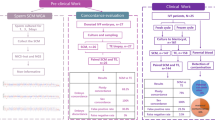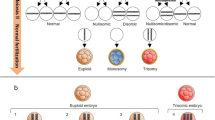Abstract
Purpose
Advances in preimplantation genetic testing (PGT) have led to practice changes in assisted reproductive technologies (ART), enabling fertility centers to transfer single embryos while maintaining excellent ongoing pregnancy rates, reducing miscarriage rates, and dramatically reducing ART-associated multiple pregnancies. The introduction of next-generation sequencing (NGS) allows PGT laboratories to assess for embryo mosaicism—although the true incidence and reproductive potential of predicted mosaic embryos are controversial. Due to concern for genetic contamination from other spermatozoa, most reference laboratories require use of intracytoplasmic sperm injection (ICSI) for single gene preimplantation genetic diagnosis (PGT-M). However, in PGT for aneuploidy (PGT-A), conventional insemination (IVF) is typically permissible. The purpose of this study was to evaluate rates of euploid, aneuploid, and mosaic in trophectoderm biopsy samples from embryos in IVF versus ICSI PGT-A cycles. Secondary aims were to assess sex ratio, and subtypes of aneuploidy and mosaicism in IVF versus ICSI PGT-A cycles.
Methods
We performed a retrospective review of women undergoing PGT-A at a single academic fertility center from July 1, 2015, to September 1, 2017. In all cycles, PGT-A was performed via trophectoderm biopsy on day 5 or 6 and analyzed using NGS at a single reference lab. We collected and compared patient demographics, fertility testing, cycle characteristics, and PGT-A outcomes between IVF and ICSI cycles.
Results
Three hundred two PGT-A cycles were included for analysis: 75 IVF and 227 ICSI cycles, resulting in 251 IVF and 724 ICSI biopsied blastocysts. Mean oocyte age of included cycles was 38.6 years (IVF) and 38.5 years (ICSI), p = 0.85. Baseline characteristics of IVF and ICSI PGT-A cycles were similar with the exception of semen parameters: IVF cycles had higher sperm concentration and total motility compared to ICSI cycles. PGT-A outcomes did not differ between IVF and ICSI cycles: euploid 27.9% (IVF) versus 30% (ICSI); aneuploid 45.4% (IVF) versus 43.1% (ICSI); no result 4.4% (IVF) versus 6.2% (ICSI). Though not significant, we identified a trend toward higher rate of mosaicism in IVF (25.9%) versus ICSI (20.9%). Among mosaic embryos, a lower percentage of simple mosaic embryos resulted from IVF (53.8%) versus ICSI (70.2%). Among aneuploid embryos, a non-significant higher percentage of complex aneuploidy resulted from IVF (16.3%) versus ICSI (9%). IVF resulted in a non-significant higher proportion of cycles with no transferrable embryos (42.7%) versus ICSI (36.6%). Numerical and sex chromosome involvement in mosaicism and aneuploidy were similar between IVF and ICSI cycles.
Conclusion
IVF and ICSI NGS PGT-A have similar rates of euploid, aneuploid, and no result embryos, though IVF may result in higher rates of mosaicism and demonstrates differences in proportions of mosaic and aneuploid subtypes compared to ICSI. ICSI may be preferable to conventional insemination to minimize the rate of mosaic results in NGS PGT-A cycles.
Similar content being viewed by others
References
Brezina PR, Kutteh WH. Clinical applications of preimplantation genetic testing. BMJ. 2015;350:g7611.
Forman EJ, Hong KH, Ferry KM, Tao X, Taylor D, Levy B, et al. In vitro fertilization with single euploid blastocyst transfer: a randomized controlled trial. Fertil Steril. 2013;100:100–7 e1.
Coates A, Kung A, Mounts E, Hesla J, Bankowski B, Barbieri E, et al. Optimal euploid embryo transfer strategy, fresh versus frozen, after preimplantation genetic screening with next generation sequencing: a randomized controlled trial. Fertil Steril. 2017;107:723–30 e3.
Dahdouh EM, Balayla J, Garcia-Velasco JA. Comprehensive chromosome screening improves embryo selection: a meta-analysis. Fertil Steril. 2015;104:1503–12.
Chen M, Wei S, Hu J, Quan S. Can comprehensive chromosome screening technology improve IVF/ICSI outcomes? A meta-analysis. PLoS One. 2015;10:e0140779.
Lee HL, McCulloh DH, Hodes-Wertz B, Adler A, McCaffrey C, Grifo JA. In vitro fertilization with preimplantation genetic screening improves implantation and live birth in women age 40 through 43. J Assist Reprod Genet. 2015;32:435–44.
Ubaldi FM, Cimadomo D, Capalbo A, Vaiarelli A, Buffo L, Trabucco E, et al. Preimplantation genetic diagnosis for aneuploidy testing in women older than 44 years: a multicenter experience. Fertil Steril. 2017;107:1173–80.
SART National summary report. 2018.
Practice Committees of the American Society for Reproductive M, Society for Assisted Reproductive T. Intracytoplasmic sperm injection (ICSI) for non-male factor infertility: a committee opinion. Fertil Steril. 2012;98:1395–9.
Group ECW. Intracytoplasmic sperm injection (ICSI) in 2006: evidence and evolution. Hum Reprod Update. 2007;13:515–26.
Thornhill AR, deDie-Smulders CE, Geraedts JP, Harper JC, Harton GL, Lavery SA, et al. Best practice guidelines for clinical preimplantation genetic diagnosis (PGD) and preimplantation genetic screening (PGS). Hum Reprod. 2005;20:35–48.
Esteves SC, Roque M, Bedoschi G, Haahr T, Humaidan P. Intracytoplasmic sperm injection for male infertility and consequences for offspring. Nat Rev Urol 2018.
Yu HT, Yang Q, Sun XX, Chen GW, Qian NS, Cai RZ, et al. Association of birth defects with the mode of assisted reproductive technology in a Chinese data-linkage cohort. Fertil Steril. 2018;109:849–56.
Pereira N, O’Neill C, Lu V, Rosenwaks Z, Palermo GD. The safety of intracytoplasmic sperm injection and long-term outcomes. Reproduction. 2017;154:F61–70.
Munne S, Wells D. Detection of mosaicism at blastocyst stage with the use of high-resolution next-generation sequencing. Fertil Steril. 2017;107:1085–91.
Popovic M, Dheedene A, Christodoulou C, Taelman J, Dhaenens L, van Nieuwerburgh F, et al. Chromosomal mosaicism in human blastocysts: the ultimate challenge of preimplantation genetic testing? Hum Reprod. 2018;33:1342–54.
Munne S, Blazek J, Large M, et al. Detailed investigation into the cytogenetic constitution and pregnancy outcome of replacing mosaic blastocysts detected with the use of high-resolution next-generation sequencing. Fertil Steril. 2017;108:62–71 e8.
Cooper TG, Noonan E, von Eckardstein S, Auger J, Baker HWG, Behre HM, et al. World Health Organization reference values for human semen characteristics. Hum Reprod Update. 2010;16:231–45.
Palmerola KL, Rudick BJ, Lobo RA. Low estradiol responses in oocyte donors undergoing gonadotropin stimulation do not influence clinical outcomes. J Assist Reprod Genet. 2018;35:1675–82.
Gardner DK, Schoolcraft WB. Culture and transfer of human blastocysts. Curr Opin Obstet Gynecol. 1999;11:307–11.
Kushnir VA, Darmon SK, Barad DH, Gleicher N. Degree of mosaicism in trophectoderm does not predict pregnancy potential: a corrected analysis of pregnancy outcomes following transfer of mosaic embryos. Reprod Biol Endocrinol. 2018;16:6.
Spinella F, Fiorentino F, Biricik A, Bono S, Ruberti A, Cotroneo E, et al. Extent of chromosomal mosaicism influences the clinical outcome of in vitro fertilization treatments. Fertil Steril. 2018;109:77–83.
Inoue N, Lopez R, Delgado A, Nuñez D, Portella J, Noriega-Hoces L, et al. Mosaic embryo transfer after oocyte in vitro maturation in combination with non-invasive prenatal testing (NIPT)-first report of a euploid live birth. J Assist Reprod Genet. 2017;34:1199–205.
Society PGDI. PGDIS position statement on chromosome mosaicism and preimplantation aneuploidy testing at the blastocyst stage. 2016.
Author information
Authors and Affiliations
Corresponding author
Ethics declarations
Competing interests
The authors declare that they have no competing interests.
Rights and permissions
About this article
Cite this article
Palmerola, K.L., Vitez, S.F., Amrane, S. et al. Minimizing mosaicism: assessing the impact of fertilization method on rate of mosaicism after next-generation sequencing (NGS) preimplantation genetic testing for aneuploidy (PGT-A). J Assist Reprod Genet 36, 153–157 (2019). https://doi.org/10.1007/s10815-018-1347-6
Received:
Accepted:
Published:
Issue Date:
DOI: https://doi.org/10.1007/s10815-018-1347-6




